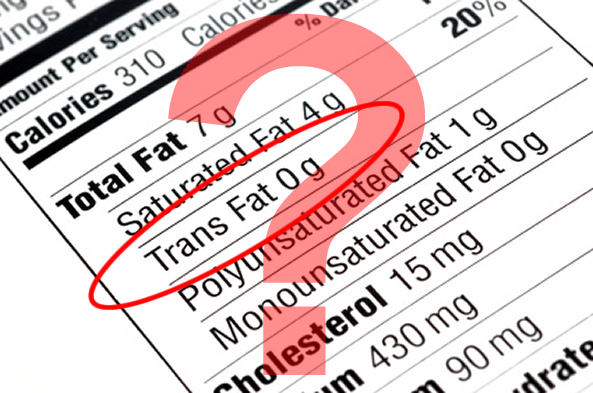It is a known fact that trans fatty acids, commonly referred to as “trans fats,” are deadly, even at low levels. Industrially produced partially hydrogenated vegetable oils are the most common source of trans fats in a typical diet.
Once thought to be a better alternative to saturated fat, trans fats began to be used widely by food companies. It was cheap and it helped foods last longer on the shelf, and if it was better for you than butter, then it was a win for everyone, right?
You probably know the story. Eventually studies showed just how damaging this experiment in food really is, and so health authorities recommended that trans fats be reduced to trace amounts, no more than 1% of your daily caloric intake, or 2 grams based on a diet of 1800 calories.
A recent study warns that while food companies have reduced the amount of trans fats in some of their products, the use of this harmful fat is still alive and well, and many of us are still consuming way more deadly trans fats that we realize.
Why are trans fats so bad again? Let’s review.
Heart Disease
Trans fats lower beneficial HDL cholesterol and increase levels of “bad” LDL cholesterol, dramatically increasing the risk of coronary heart disease. By 2006, upwards of 100,000 cardiac deaths annually in the U.S. were attributed to the consumption of trans fats.
Alzeimer’s Disease
In a rat study, trans fats impaired memory and learning. Trans fats reduced the proteins needed for healthy brain function and caused inflammation around the part of the brain responsible for learning and memory. This may help explain why a previous study on over 800 people published in JAMA Neurology concluded that “high intake of unsaturated, unhydrogenated fats may be protective against Alzheimer disease, whereas intake of saturated or trans-unsaturated (hydrogenated) fats may increase risk.”
Obesity
Research shows that trans fats might cause weight gain and abdominal fat even when we are not overeating. In a 6-year study, monkeys that ate a trans fat diet gained 7.2% of their body weight compared to only 1.8% in moneys on a mono-unsaturated diet.
Infertility
In one recent study, for every 2% increase in the intake of trans fats as opposed to carbohydrates, there was a 73% greater risk of infertility in women.
Depression and Behavior Problems
Trans fats may suppress DHA levels in the brain. When Spanish researchers analyzed the food intake of over 12,000 people over a period of 6 years, they found that the ones who ate the most trans fats had a 48% higher risk of depression than those that did not eat trans fats. And in an observational analysis of a study, trans fats were linked with aggression and irritability.
I find this evidence reason to completely eliminate trans fats from my diet, and likely you feel the same.
Unfortunately, it’s not as easy as checking the Nutrition Facts label on the package for Trans Fats. The FDA allows food companies to list Trans Fats as “0” if the trans fat in the product is less than .5 grams per serving. And as we all know, those serving sizes are rarely realistic. (Ever eat just one cookie?) Eat the bag of chips or cookies with 3 servings, and you have probably maxed out your 2 grams per day recommended upper limit.
While food companies have responded by reducing their use of partially hydrogenated oils, they have not done nearly enough.
In an analysis of 270 food products that included major brands from General Mills, Kellogg Company, ConAgra, Safeway and Walmart, 66% of them had reduced their trans fat content between 2007 and 2011. The majority (82%) listed 0 grams of fat (per FDA guidelines) but only half had completely removed these partially hydrogenated oils from their foods. And if you view all 270 products, including those that did not reformulate their products to significantly reduce trans fat, the overall reduction of trans fat fell only 49% from 1.9 grams per serving to 0.9 grams per serving.
“Given the very strong association between trans fat and adverse health effects, any reduction in prevailing exposure is a good thing,” said David Katz, MD. “But on the other hand … with all of the attention to harmful effects of trans fat, and the availability of alternatives, how is it that manufacturers can still sell, and the public will still buy, products ‘contaminated’ with this substance?”
Yes, he calls these products “contaminated.” They really are that bad. (There is even a Trans Fat Wall of Shame Pinterest Board!)
How to Eliminate Trans Fats
The only way to know if a product is truly trans fat free is to check the ingredient list. Look for anything that says “partially hydrogenated,” and if you see it, put it back on the shelf or toss it into the garbage.
If you see “0 Grams Trans Fat per Serving!” emblazoned on the package, consider this a red flag and check the ingredient list. It likely has trans fats lurking just under the .5 grams per serving FDA rule.
Be especially vigilant in the deli and bakery section of the grocery store. Food is often fried in partially hydrogenated oils, and the baked goods often contain it as well, since they help foods last longer on the shelf. Ask the employees behind the counter what oil they cooked the food in, and check the adhesive tag on baked goods.
Refrigerated cookie dough, frozen pies and pie crusts, frozen dinners, and biscuits in a can are all major offenders.
The food companies are focused on selling you as much processed food as possible. They are not concerned about your health. Prevent trans fats from sneaking into your diet by becoming an ingredient list reader and teach your family to do the same. There are so many better choices available. We can protect our health if we just take a look.
Pantry Check: Check your pantry for products containing trans fats, and share what you found by commenting below.








Leave A Comment